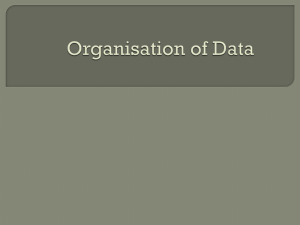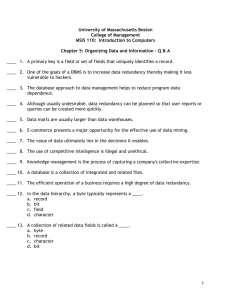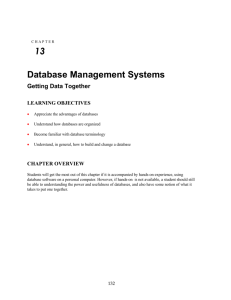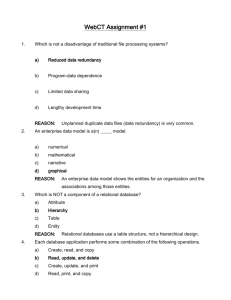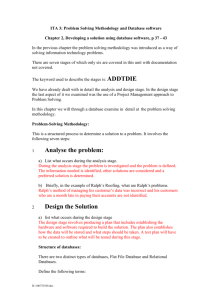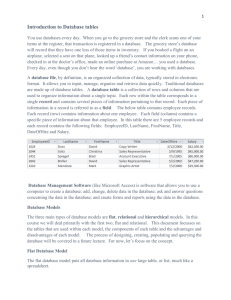Database Approach: Entities, Relationships, and DBMS
advertisement
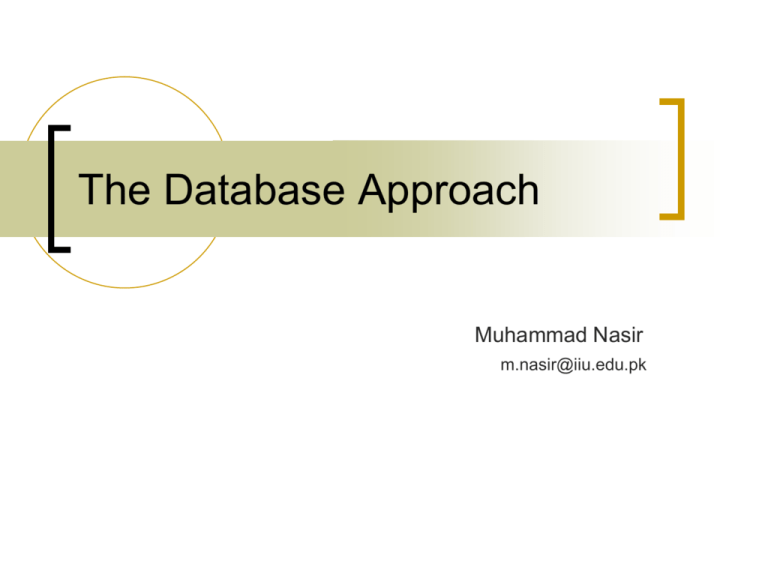
The Database Approach Muhammad Nasir m.nasir@iiu.edu.pk Outline Entity Relational Database Relationship Database Management System Advantages of Database Approach Program-data independence Planned data redundancy Improved data consistency Improved data sharing Increased productivity of application development Enforcement of standards Improved data quality Improved data accessibility and responsiveness Reduced program maintenance Improved decision support Database Approach Entity A person, a place, an object, an event, or a concept in the user environment about which the organization wishes to maintain data. Database Approach Relational Database A database that represents data as a collection of tables in which all data relationships are represented by common values in related tables. Database Approach RELATIONSHIPS A well-structured database establishes the relationships between entities that exist in organizational data so that desired information can be retrieved. Most relationships are one-to-many (1:M) or manyto-many (M:N). A customer can place more than one order with a company. Database Approach Database Approach Database Management System (DBMS) A software system that is used to create, maintain, and provide controlled access to user databases. Components of Database Environment Advantages of the Database Approach Program-data independence Planned data redundancy Improved data consistency Improved data sharing Increased productivity of application development Enforcement of standards Improved data quality Improved data accessibility and responsiveness Reduced program maintenance Improved decision support Program Data Independence The separation of data descriptions (metadata) from the application programs that use the data is called data independence. With the database approach, data descriptions are stored in a central location called the repository. Planned Data Redundancy Good database design attempts to integrate previously separate (and redundant) data files into a single, logical structure. Ideally, each primary fact is recorded in only one place in the database. Improved Data Consistency By eliminating or controlling data redundancy, we greatly reduce the opportunities for inconsistency. For example, if a customer’s address is stored only once. When the customer’s address changes, recording the new address is greatly simplified because the address is stored in a single place. Finally, we avoid the wasted storage space that results from redundant data storage. Improved Data Sharing Data can be accessed across the Departments For example, an employee working in human resources will need access to confidential employee data; a customer needs access to the product catalog available on Pine Valley’s Web site. Increased productivity of application development Database applications can often be developed much more rapidly than conventional file applications Provide a number of rapid application development tool i.e. Form Builder Database Designing Enforcement of Standards Login credentials Controlled access with privileges and roles Database approach is implemented with full management support, the database administration function should be granted single point authority and responsibility for establishing and enforcing data standards. Improved Data Quality The database approach provides a number of tools and processes to improve data quality Referential Integrity Contracts Indexes Improved data accessibility and responsiveness With relational database, end users without programming experience can often retrieve and display data, even when it crosses traditional departmental boundaries. The language used in this query is called Structured Query Language, or SQL Reduced Program Maintenance Maintenance in Database have little or not effect on the Database Application thus reducing the maintenance costs Improved Decision Support Some databases are designed expressly for decision support applications. For example, some databases are designed to support customer relationship management, whereas others are designed to support financial analysis or supply chain management. The End Thanks for listening Questions would be appreciated.
